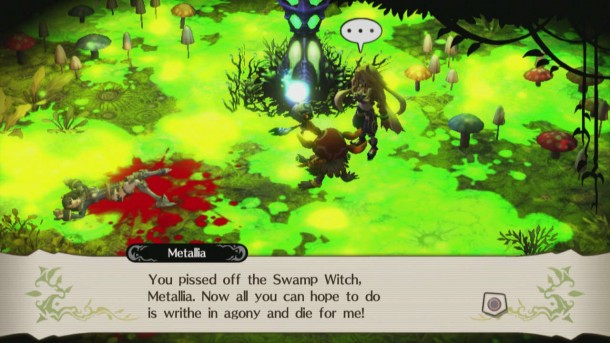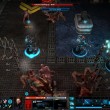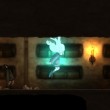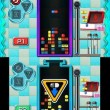The Witch and the Hundred Knight Review
In many ways, The Witch and the Hundred Knight represents a distinct departure from NIS's norm. Instead of following the company's usual strategy role-playing game formula, Witch is a loot-collecting, combat-heavy action RPG. Rather than 2D sprites, the game is populated with 3D character models. And where most NIS offerings feature a lighthearted, humor-infused story, The Witch and the Hundred Knight features a dark story beneath its charming anime illustrations. The result is an interesting, ambitious game that, unfortunately, takes its sweet time in becoming enjoyable.
The Witch and the Hundred Knight is a tale about the titular duo, the swamp witch Metallia and a squat, humanoid magical creature called the Hundred Knight, which she has summoned from another realm. Metallia has been confined to her swamp for years, and during that time, she has developed a fierce hatred of, well, just about everything. She aims to destroy the other witches of the world and expand her marshland territory. When the hidden Pillars of Temperance scattered throughout the land are released, Metallia's murky swamp waters can flow more freely across the world, augmenting her power and giving her more freedom to move about, but since she is confined to her swamplands, the task is up to you, playing as the Hundred Knight. There are some interesting nuances to the plot introduced from the get-go--such as Metallia's impending death and the mysterious origins and hidden power of the feeble-looking Hundred Knight--but the majority of the early story is spent releasing the power of the pillars and destroying the other witches that stand in Metallia's way.
The setup sounds fairly straightforward, but the gameplay is anything but. A (too) lengthy introductory tutorial teaches you the most basic elements of moving, running, dodging, and attacking, but once you're in Metallia's house, the game stops holding your hand and leaves the Hundred Knight to fend for himself, save for some brief pop-ups and scattered explanations during loading times. And is it ever a tough learning curve.
The most important gameplay element in Witch--and one that isn't explained well--is the GigaCals, or GCals. Metallia can't leave her swamplands, so she sends the Hundred Knight to do her bidding, but he needs GCals to make use of her magic power. Much like a hunger meter in a roguelike game, the Hundred Knight's GCals are constantly draining, and certain factors--such as the area being explored or damage taken from enemies--cause GCals to deplete faster. As long as the Hundred Knight has GCals, he can be killed and revived (at a massive GCal cost), but once the GCals run out, he takes a huge reduction in power and is ejected from the dungeon upon knockout. There are ways to refill GCals within the dungeons: using grade points earned from defeating enemies, partaking in healing items from your stash, or even eating foes that are on the verge of death (at the cost of filling up the Hundred Knight's loot-storing stomach with garbage).
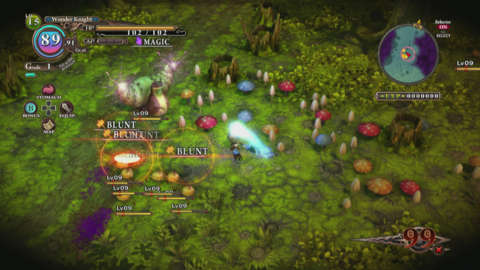
Since the dungeons are large, and enemies can be dangerous, it's important not to act frivolously; every movement, strike, or misstep can have a serious cost. The slow, weighty strikes of the Hundred Knight's weapon combos and dodge moves add to this feeling, plus a stamina bar prevents you from going hog wild with combo attacks and running. The design of dungeon exploration and combat lends a satisfying risk/reward element to your actions, and while it's more forgiving than in a typical roguelike--every stage has numerous pillar checkpoints that allow you to return to base and refill GCals--it still challenges you to try to stick it out as long as you can in a stage with the ever-tantalizing prospect of more experience, better stat boosts, and high-level bonus loot. (Of course, if you get knocked out, you can kiss some of these hard-earned rewards goodbye.)
In addition to the GCals are numerous other gameplay elements that make Witch unique. The Hundred Knight can equip up to five weapons at once, and carefully leveling them up and balancing their attributes creates fantastic, incredibly damaging combos. Tochkas are magical skills you earn throughout the game that create varied and interesting effects, from simple projectile attacks to traps and damaging decoys. Enemies have emotions that can be manipulated through certain attacks, with certain attacks scaring them to death or making them fall in love with you (and thus becoming temporary aides). Homes in villages can be raided for valuable treasures and key items. The Hundred Knight can equip and swap between various "facets," each with its own experience levels, proficiencies, and special augmentations.
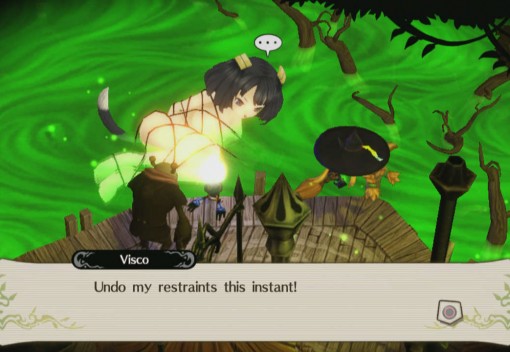
There are a lot of interesting gameplay ideas to experiment with, which makes the fact that so many of them are barely explained in-game incredibly frustrating. At the five-hour mark, I finally learned about consuming enemies after checking my control scheme and seeing what the button combination was; the hint screens I'd seen so far had only mentioned the act without explaining how to do it. At the 15-hour mark, I felt like I was still learning some of the basics of using tochkas. It wasn't until about 25 hours in that I finally felt comfortable with everything I could do in the game, and most of what I had learned had been through harsh trial and error. (Getting killed rapidly in the beginning of the game's third dungeon forces you to learn pretty quickly, I must say.) Once you do have a handle on everything, seeing the way the various gameplay elements flow together is fun and satisfying, but getting to that point is extremely rough. Some overly long and repetitive dungeons and lengthy story sequences certainly don't help endear the game to you early on, either, but at least the fantastic soundtrack makes those drawn-out stretches of learning experiences more bearable.
Even beyond the harsh learning curve, however, there's one big thing that could turn you off to The Witch and the Hundred Knight early on, and that's Metallia's outright deplorable personality and behavior. Unlike the mischievous demon protagonists of Disgaea, who went about their dastardly deeds with an air of cartoonish camp, Metallia's actions toward others are outright abusive and vile, with little hint of humor. She frequently degrades her foes in both words and actions, cussing up a storm and delighting in torturing her fallen enemies while they're down. A good example of her awfulness comes after beating the first major foe of the game: after defeating her foe, Metallia kicks her until she throws up, refers to her as a "vomiting whore" (which sticks for the rest of the game), transforms her into a mouse, and sends male mice after her with the heavy implication that they will sexually assault her. This one scene alone might have you wondering if it's best to shut the game off and walk away.
There are a lot of interesting gameplay ideas to experiment with, which makes the fact that so many of them are barely explained in-game incredibly frustrating.
Metallia's not alone in being a horrible person--many of the game's other characters are distinctly awful in their own ways--but it still feels very uncomfortable doing the bidding of such a nasty character. Equally distressing is seeing many of the game's more relatable characters develop a weird case of Stockholm syndrome-like affection toward her despite suffering her terrible abuse. While there is some redemption for Metallia as the story progresses, it doesn't occur until late in the game, which is far longer than is tolerable. The Witch and the Hundred Knight isn't the first time NIS has dealt with darker stories--the post-game Demon Path in Soul Nomad and a few Disgaea series endings come to mind--but it is the first where you feel forced down such a demoralizing path.
Witch certainly has its merits, and it rewards you for the time you're willing to invest in learning its nuances. But between the badly designed learning curve and the utterly unappealing lead, it's quite the challenge to get to that point. It's nice to see NIS applying its unique and complex approach to game design to different genres, but I hope that its next effort will be a bit more welcoming from the outset. (And, hopefully, involve less mouse molestation.)

